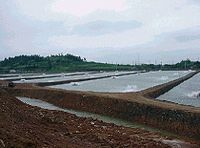
Photo from wikipedia
Abstract The continued success of shrimp farming will rely on improved feed management and reductions in labor costs. Shrimp are omnivorous, eating many small meals with limited stomach capacity for… Click to show full abstract
Abstract The continued success of shrimp farming will rely on improved feed management and reductions in labor costs. Shrimp are omnivorous, eating many small meals with limited stomach capacity for food storage. Hence, increased performance may be obtained by spreading feed through multiple meals. Initial work has demonstrated that moving from two feeding per day into multiple feeding systems increases growth rate and production. Further advances have been made with on-demand (satiation) feeding systems. The goal of this work was to continue the development of standard feeding protocol's (SFP) for automatic feeding systems to maximize growth rates in semi-intensive pond production of shrimp, Litopenaeus vannamei. For this work a 13-week pond production trial was performed in 16, 0.1 ha outdoors ponds, stocked at a 26 shrimp/m2, and fed 1.5-mm 40% crude protein for the first four weeks, and 2.4-mm protein soy optimized feed (35% crude protein) for last nine weeks, both produced by Zeigler Inc. Four treatments including: three fixed feeding treatments of 130, 145 and 160% of a SFP (SFP + 30%, SFP + 45%, SFP + 60%, respectively) were offered using automatic timer-feeders, and a fourth treatment utilized on-demand AQ1 acoustic feeding system. No statistical differences were found between treatments for survival (ranging 75.2–81.4%) and FCR (ranging 0.96–1.11). In general, increased feed inputs resulted in higher production. The best response was with the AQ1 system which adjusted feed inputs in real time and ended up offered higher feed inputs resulting in larger shrimp and yields. Based on results of this work and previous trials, standard feeding protocols for automated systems can be developed but to date, automated feedback systems which operate in real time out perform the standardized practices.
Journal Title: Aquaculture
Year Published: 2020
Link to full text (if available)
Share on Social Media: Sign Up to like & get
recommendations!